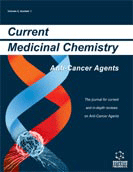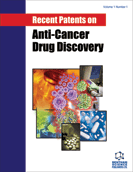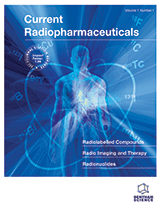Abstract
Camptothecins selectively target topoisomerase I (Top1) by trapping the catalytic intermediate of the Top1- DNA reaction, the cleavage complex. Hence, camptothecins represent a paradigm for targeting macromolecular interactions. Instead of preventing the binding of the two macromolecules they target (Top1 and DNA), camptothecins slow down the dissociation of these macromolecules. The activity of camptothecins underlines the usefulness of screening for drugs that inhibit the dissociation of macromolecules. Camptothecins and non-CPT Top1 inhibitors are being developed to improve the pharmacodynamics, pharmacokinetics and clinical pharmacology of camptothecins, and it is likely that drugs with improved anticancer activity will be discovered. Although Top1 is the only primary target of camptothecins, the mechanisms of camptothecins anticancer activity rest beyond the formation of cleavage complexes. Indeed, Top1 cleavage complexes lead to replication- (and transcription-) mediated DNA damage. It is likely that DNA damage can be repaired more efficiently in normal than in cancer cells that are intrinsically deficient for DNA repair and cell cycle checkpoints. Evaluating such deficiencies in clinical samples is becoming possible. If specific deficiencies are associated with clinical responses, their detection should guide therapeutic decisions. Furthermore, targeting DNA repair (Tdp1) and checkpoints (ATM, Chk1 and Chk2) might increase the selectivity of Top1 inhibitors for tumors, thereby increasing the antitumor activity while reducing the side effects of Top1 inhibitors.
Keywords: camptothecins, indolocarbazoles, indenoisoquinolines, dna repair, checkpoints
Current Medicinal Chemistry - Anti-Cancer Agents
Title: Camptothecins and Topoisomerase I; A Foot in the Door. Targeting the Genome Beyond Topoisomerase I with Camptothecins and Novel Anticancer Drugs; Importance of DNA Replication, Repair and Cell Cycle Checkpoints
Volume: 4 Issue: 5
Author(s): Yves Pommier
Affiliation:
Keywords: camptothecins, indolocarbazoles, indenoisoquinolines, dna repair, checkpoints
Abstract: Camptothecins selectively target topoisomerase I (Top1) by trapping the catalytic intermediate of the Top1- DNA reaction, the cleavage complex. Hence, camptothecins represent a paradigm for targeting macromolecular interactions. Instead of preventing the binding of the two macromolecules they target (Top1 and DNA), camptothecins slow down the dissociation of these macromolecules. The activity of camptothecins underlines the usefulness of screening for drugs that inhibit the dissociation of macromolecules. Camptothecins and non-CPT Top1 inhibitors are being developed to improve the pharmacodynamics, pharmacokinetics and clinical pharmacology of camptothecins, and it is likely that drugs with improved anticancer activity will be discovered. Although Top1 is the only primary target of camptothecins, the mechanisms of camptothecins anticancer activity rest beyond the formation of cleavage complexes. Indeed, Top1 cleavage complexes lead to replication- (and transcription-) mediated DNA damage. It is likely that DNA damage can be repaired more efficiently in normal than in cancer cells that are intrinsically deficient for DNA repair and cell cycle checkpoints. Evaluating such deficiencies in clinical samples is becoming possible. If specific deficiencies are associated with clinical responses, their detection should guide therapeutic decisions. Furthermore, targeting DNA repair (Tdp1) and checkpoints (ATM, Chk1 and Chk2) might increase the selectivity of Top1 inhibitors for tumors, thereby increasing the antitumor activity while reducing the side effects of Top1 inhibitors.
Export Options
About this article
Cite this article as:
Pommier Yves, Camptothecins and Topoisomerase I; A Foot in the Door. Targeting the Genome Beyond Topoisomerase I with Camptothecins and Novel Anticancer Drugs; Importance of DNA Replication, Repair and Cell Cycle Checkpoints, Current Medicinal Chemistry - Anti-Cancer Agents 2004; 4 (5) . https://dx.doi.org/10.2174/1568011043352777
| DOI https://dx.doi.org/10.2174/1568011043352777 |
Print ISSN 1568-0118 |
| Publisher Name Bentham Science Publisher |
Online ISSN 1875-5968 |
 5
5Related Articles
-
Structural Basis and Therapeutic Implication of the Interaction of CCN Proteins with Glycoconjugates
Current Pharmaceutical Design Gene Therapy Using an Adenovirus Vector for Apoptosis-Related Genes is a Highly Effective Therapeutic Modality for Killing Glioma Cells
Current Gene Therapy A New Series of Triazolothiadiazines as Potential Anticancer Agents for Targeted Therapy of Non-Small Cell Lung and Colorectal Cancers: Design, Synthesis, <i>In silico</i> and <i>In vitro</i> Studies Providing Mechanistic Insight into Their Anticancer Potencies
Medicinal Chemistry <sup>99m</sup>Tc-EDDA/HYNIC-TOC is a New Opportunity in Neuroendocrine Tumors of the Lung (and in other Malignant and Benign Pulmonary Diseases)
Current Radiopharmaceuticals The Targets of Curcumin
Current Drug Targets WISP1 (CCN4) Autoregulates its Expression and Nuclear Trafficking of β-Catenin during Oxidant Stress with Limited Effects upon Neuronal Autophagy
Current Neurovascular Research Bladder Cancer: A Simple Model Becomes Complex
Current Genomics Genes Associated with Epithelial-Mesenchymal Transition: Possible Therapeutic Targets in Ductal Pancreatic Adenocarcinoma?
Anti-Cancer Agents in Medicinal Chemistry A Constrained Probabilistic Matrix Decomposition Method for Predicting miRNA-disease Associations
Current Bioinformatics New Framework for the Discovery of PRC2 Inhibitors: Epigenetic Drugs
Current Drug Targets Alpha-Particle Microdosimetry
Current Radiopharmaceuticals Induction of Senescent-Like Growth Arrest as a New Target in Anticancer Treatment
Current Cancer Drug Targets Role of Genetic Interactions in Lung Diseases Detection Using Computational Approaches: A Review
Current Chinese Computer Science Hepatocellular Carcinoma Detection by Gallium Scan and Subsequent Treatment by Gallium Maltolate: Rationale and Case Study
Anti-Cancer Agents in Medicinal Chemistry The Effects of Nanoencapsulated Curcumin-Fe3O4 on Proliferation and hTERT Gene Expression in Lung Cancer Cells
Anti-Cancer Agents in Medicinal Chemistry Cancer Stem Cells of Head and Neck Squamous Cell Carcinoma
Current Cancer Therapy Reviews Dendritic Cells and their Receptors in Antitumor Immune Response
Current Molecular Medicine Circular RNAs and Glioma: Small Molecule with Big Actions
Current Molecular Medicine The Role of ABC and SLC Transporters in the Pharmacokinetics of Dietary and Herbal Phytochemicals and their Interactions with Xenobiotics
Current Drug Metabolism Evaluation of Adhesion Force and Binding Affinity of Phytohemagglutinin Erythroagglutinating to EGF Receptor on Human Lung Cancer Cells
Current Medicinal Chemistry


















